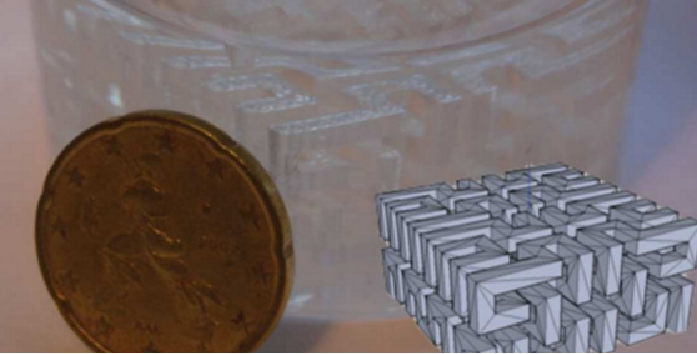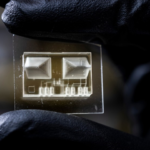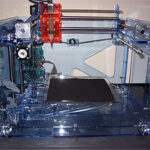

ESGARGOT. For some of us, this brings to mind a pricey appetizer in the form of a land snail usually spiced up with garlic, herbs, and butter. While many may have not tasted the delicacy or even heard of it, fewer yet will have heard about a recent study cleverly given this acronym–but bearing results that may one day be very important for many engineers and scientists to try working with, according to a research team of scientists at Wageningen University in the Netherlands and the University of Castilla-La Mancha, Spain.
And while your tastebuds might be working ahead of mealtime now, we’re actually taking time to discuss something much different from snails on the half shell. Here, organs on a chip would be a more appropriate definition. Formally titled Embedded SCAffold RemovinG Open Technology (ESCARGOT), this method involves fabricating vessels for silicone microfluids with your everyday ABS filament. That’s just about the only ‘everyday’ component of this project, although it is meant to simplify the complexities of the current standard microfluidics fabrication processes.
Breaking that down, what we are talking about in its most concise form are tiny vessels carrying very, very small amounts of liquid. The study of microfluidics generally includes the manipulation of varying liquids on the sub-millimeter scale, often used in chip technology and printing. Polydimethylsiloxane (a variety of silicone compounds), known for its unusual flow properties as well as its affordability, permeability, and its refractive index–very similar to that of glass–has been the standard in materials for making microfluidic devices up until now.
According to researchers, however, PDMS has not been very conducive to 3D printing all around, both for the reasons that most scientists are not familiar with using it for those applications, and it is difficult to use in that process regardless. Just published in Advanced Science, Vittorio Saggiomo and Aldrik Velders outline their findings for making this process easier in ‘Simple 3D Printed Scaffold Removal Method for the Fabrication of Intricate Microfluidic Devices.’
Saggiomo and Velders have come up with a solution in using ABS as a scaffold for creating micrometric-sized channels with a single block of the liquid PDMS. With a dual-step method featuring scaffold removal method, they are able to cut out time-consuming lithography steps as well as template preparation.
“We extruded ABS plastic with the aid of a 500 μm nozzle giving filaments of approximately the same diameter. These scaffolds were then suspended into liquid PDMS and the latter was cured at 75 °C for 2 hours, after which it was immersed in acetone for 12 hours, dissolving the scaffolds,” stated the scientists in their paper.
“Acetone was the solvent of choice for dissolving ABS whilst its swelling ratio (S) for PDMS is as low as 1.06. A final flushing with acetone completely cleaned the inner channel, creating de facto a PDMS microfluidic device.”
The team was able to create many different channels with their scaffold removal method:

- Spiral channels
- Multichannels of varying geometries
- Channels of varying sizes
- A multilevel scaffold based on the Hilbert curve
Additionally, they integrated the following into these channels:
- Stirring bars
- Electronic circuitry
- Heating element
- Radiofrequency (RF) components
They also discovered that they were able to solve heat issues, controlling temperature by placing a heating unit inside the microfluidic devices. Using a 200 μm Nichrome resistance wire wrapped around the ABS polymer scaffold, they inserted it into PDMS. What they found is that temperatures could not only be varied within the channel–they could even boil water inside it.
“This simple and selective heating element embedded in the microfluidic chip can be of great value for designing chips to perform, e.g., biological experiments such as PCR, sterilization inside the microchannels or for setting different temperatures for organ-on-chips or cell cultures,” stated the scientists.
Discussing nuclear magnetic resonance spectroscopy as ‘arguably one of the most powerful analytical tools available to the scientific community,’ the team also decided to use their scaffold-removal concept to also fabricate a cheap yet very sensitive NMR sensor by wrapping copper wire around the filament, making a final channel.
“This microfluidic device was integrated on a cylindrical aluminum probe insert and placed inside a 9.4 T narrow-bore superconducting NMR magnet,” stated the researchers.
They were also able to, offering ‘last proof of the versatility of the ABS scaffold-removal method,’ embed both a color sensor and an Arduino microcontroller within the devices, wired together, and integrated into a scaffold.
“After curing the PDMS and removing the ABS polymer with acetone, the resulting microfluidic channel was right on top of the color sensor,” stated the scientists. “Hooking up the Arduino to a computer revealed all the components of the microcontroller and the sensor to be working properly.”
“Thus, even complex electronics can be easily embedded in PDMS microfluidic devices reducing the amounts of external components needed for using, screening and analyzing experiments in microfluidics devices.”
While the scientists admit this process is definitely still in its beginning stages and they can still offer improved in areas like texture and channel size, they were able to conclude that this new process involving ABS scaffold-removal is easier and more affordable in comparison to today’s methods. They were impressed at the power and versatility gained as they 3D printed multilevel channels in PDMS, as well as being able to add heating coils, and electrical components into the PDMS devices. Solving many of the previous issues in using PDMS, the team sees ESCARGOT as not only simpler but also more valuable in affording a wider range of scientists to use microfluidic devices. Discuss this story in the 3D Printed Microfluid Device Forum on 3DPB.com.
When it comes to 3D real estate visualization in the USA, our service provides the perfect solution for bringing property listings to life. Through our platform, you can easily access cutting-edge 3D renderings that showcase your real estate projects in a way that attracts potential buyers and investors. Whether it's residential, commercial, or mixed-use properties, our team of experts uses advanced technology to create immersive visualizations that highlight the best features of your property, making it easier for clients to imagine the space as their own.
Through our website, you can quickly get high-quality 3D real estate visualizations that are tailored to your specific needs. With our help, you'll stand out in the competitive real estate market by offering potential buyers a realistic, interactive view of your property. Our efficient process ensures a fast turnaround time, while our attention to detail guarantees that every aspect of the property is represented accurately, giving you a powerful marketing tool to promote your real estate listings.






